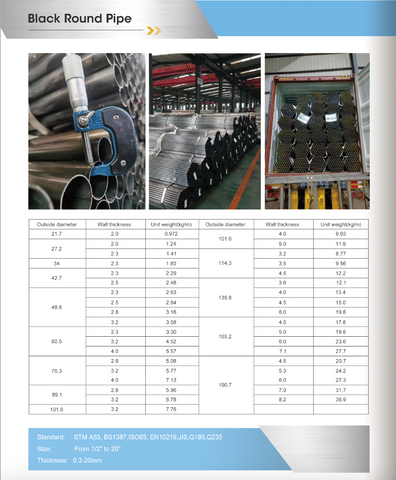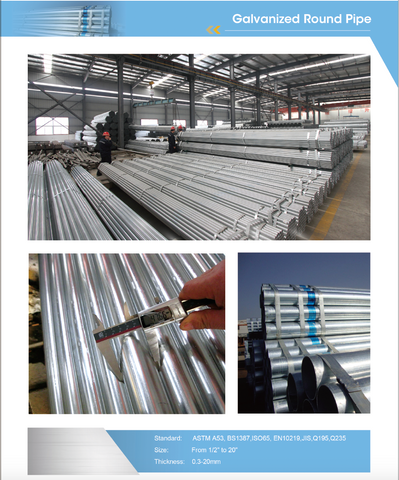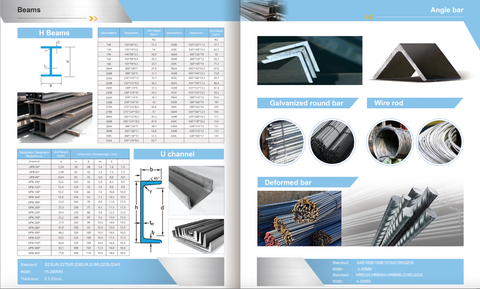Steel pipes & fittings

**Steel Black Round Pipe**
A steel black round pipe, often simply called a black pipe, is a type of steel pipe that is typically used for transporting gas and water in domestic and commercial applications. The "black" in its name comes from the dark-colored iron oxide scale that forms on its surface during the steel-making process. Here's a brief overview:
1. **Material**: Made primarily of steel, these pipes are durable and strong, making them suitable for a variety of applications.
2. **Appearance**: The surface of the pipe has a dark coloration, which is a result of the manufacturing process where the steel is subject to high temperatures. This gives the pipe its characteristic "black" appearance.
3. **Usage**: Black pipes are most commonly used for transporting water and gas in domestic and industrial settings. They can also be used for fire sprinkler systems because of their heat resistance.
4. **Sizes**: Black round pipes come in various sizes, typically specified by their nominal diameter. They can range from very small diameters for household applications to much larger diameters for industrial use.
5. **Coating**: While the pipe has a natural dark hue due to its manufacturing process, it's sometimes coated with protective oils to prevent rusting. However, in applications where the pipe will be exposed to the elements or underground, it might be galvanized (coated with zinc) to provide additional corrosion resistance.
6. **Connections**: Black pipes can be connected using threaded fittings, welding, or flanges, depending on the application and the size of the pipe.
7. **Considerations**: When using black pipes for gas transportation, it's crucial to ensure that they are correctly installed and regularly inspected for safety reasons. They can corrode over time, especially if exposed to moisture, so they might not be suitable for all outdoor applications without additional protective measures.
In recent times, due to the development of various alternative materials and the potential for corrosion in steel pipes, it's essential to consider the application and environment before choosing black steel pipes. Proper installation, maintenance, and regular inspections are crucial for the longevity and safety of these pipes.

**Galvanised Round Pipe**
A galvanized round pipe is a cylindrical pipe that has undergone a galvanization process, which involves the coating of the steel or iron pipe with a protective layer of zinc. This process helps to prevent the metal from corroding.
**Key Features**:
1. **Corrosion Resistance**: The primary purpose of galvanizing is to impart a long life to the steel by preventing corrosion. Zinc acts as a sacrificial anode, which means that even if the coating is scratched and the underlying steel is exposed, the zinc will corrode first, thereby protecting the steel.
2. **Durability**: Galvanised pipes last longer than non-galvanized ones, especially in challenging environments like underground or in places with high moisture.
3. **Round Shape**: Being round, these pipes offer a uniform structure, making them useful in various applications where consistency is essential.
4. **Versatility**: Galvanised round pipes are used in numerous applications including plumbing, fencing, agriculture, construction, and many industrial processes.
5. **Cost-effective**: While the galvanization process does add to the initial cost of the pipe, the longevity and reduced maintenance costs over the pipe's lifespan often make it a more economical choice in the long run.
When choosing a galvanized round pipe, it's essential to consider factors such as the thickness of the zinc coating, the size of the pipe, and the environment in which it will be used, as these can impact the pipe's lifespan and effectiveness.

**Steel Black Square Pipe**
**Definition:**
A steel black square pipe, often simply referred to as a "black pipe," is a type of steel pipe that has a square cross-sectional shape and is coated in a black protective layer of iron oxide. This coating is a result of the hot-forming process, which provides the pipe with a dark color.

**Features and Applications:**
1. **Protective Layer:** The black oxide layer helps protect the steel from rust and corrosion to some extent. However, for applications with high moisture exposure, additional protective treatments or coatings might be required.
2. **Versatility:** Steel black square pipes are used in various applications due to their strength and rigidity. They are often seen in construction, infrastructure, and furniture-making.
3. **Size Variation:** These pipes are available in a variety of sizes, lengths, and thicknesses, catering to different requirements.
4. **Weldability:** They are highly weldable, making them suitable for fabricating structures that require joining of components.
5. **Malleability:** Despite their robustness, these pipes can be bent or molded into desired shapes, subject to the right processes and conditions.
6. **Cost-effective:** They offer a combination of durability and cost-effectiveness, making them an attractive choice for several applications.
7. **Aesthetic:** Some designers and architects prefer the industrial look of black square pipes, utilizing them in various interior design projects.
**Points to Note:**
- Over time and without additional protection, the iron oxide layer can corrode, leading to rust formation.
- They might not be suitable for carrying drinking water or gas as the black oxide layer can flake off and contaminate the transported substance.
When selecting a steel black square pipe for specific applications, it's crucial to consider factors like the required strength, corrosion resistance, and overall suitability for the job.

Steel beams, angle bars, and pipes are all essential structural and architectural components used in various construction and industrial applications. Here's a brief intro to each:
1. **Steel Beams**
- **Purpose**: Primarily used to provide support in buildings and bridges.
- **Types**:
- **I-beams (or H-beams)**: Resemble the letter "I" in shape. They offer a good balance between strength, weight, and cost.
- **U-beams (or C-beams)**: Channel-shaped beams.
- **T-beams**: Resemble the letter "T".
- **Material**: Typically made from structural steel, though the exact composition can vary.
- **Benefits**: High strength-to-weight ratio, durability, and the ability to span large distances.
2. **Angle Bars (or Angle Iron)**
- **Purpose**: Used for a variety of purposes including structural and decorative applications.
- **Shape**: L-shaped cross-section.
- **Material**: Usually made of iron or steel.
- **Benefits**: Provide excellent support and reinforcement, especially in corners or areas where two surfaces meet.
3. **Pipes**
- **Purpose**: Used to convey liquids, gases, or solids or as structural components.
- **Types**:
- **Seamless Pipes**: Made without a weld seam.
- **Welded Pipes**: Formed by bending and welding a flat piece of steel.
- **Material**: Can be made from a variety of materials including carbon steel, stainless steel, and more.
- **Benefits**: Depending on the material, steel pipes can be very durable and resistant to corrosion, high temperatures, and high pressures.
Each of these structural elements offers a unique set of properties, making them suitable for specific applications. When designing structures, engineers choose the appropriate type based on the requirements of the project, considering factors like load-bearing capacity, span length, environmental conditions, and more.
